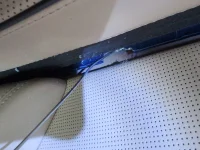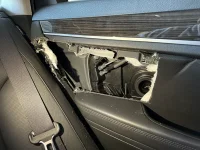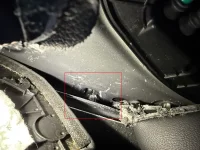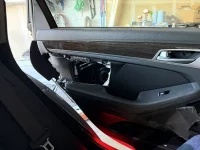I know this thread has been around for a few years but I'm assuming there are people out there still looking for a fix.
The quick summary:
I was able to replace a friend's 2015 Genesis rear door latch without damaging the door interior panel. This may or may not apply to other models/years; you will need to evaluate your vehicle's door latch mechanism, etc. to decide if this fix will work for you.
I'm going to do a quick post to let people know what I've found and see if there's interest in more detail. Pardon the bullet points:
- In order to replace the broken latch mechanism, the interior door panel has to be removed, and as far as I can tell the door has to be open to remove the panel. Which, of course, you can't do because the latch is broken. Catch 22!
- With the assumption that the problem affecting other Genesis doors is the same as the one I repaired, you will NOT be able to get the door open with a slim-jim or other through-the-window-opening approach. The broken piece is buried deep within the door latch mechanism, and is in the internal linkage operated on by both the outside and inside handle cables. No amount of manipulation of the cables will make up for the fact that the linkage inside the latch assembly itself is broken.
- I spent several hours with a snake-cam looking inside the door and evaluating an unmounted replacement latch assembly to see if I could find a through-the-window exploit. Unless you have access to NASA-level or aircraft mechanic tools where you can work through a half-inch opening and maneuver a drill around three corners to bore holes in the back of the latch then you are out of luck.
- But: I did find another way to cause the latch to release and open the door! To understand how this works, it helps if you can open the door on the other side of the car and use a screwdriver to push the latch-pivot mechanism on the door's edge to simulate how the latch engages when the door closes. Note that there's a small black 'cam' at the outside-bottom of the latch-pivot that snaps up and holds the latch in its door-is-closed position. If you can press on that small back cam in just the right way, the latch-pivot will release. There's your exploit!
The general process:
Working from inside the car, pull the interior door seal away from the lower rear edge of the door frame by the rear seat bottom and back. This will expose a pinch-weld (I think it's called that) that sits between where you're sitting and the now-we-know-how-to-exploit-latch-mechanism. Use a Dremel tool outfitted with a 9901 Tungsten Carbide metal bit - they're $10-15 but worth it - to grind away a 'notch' in the pinch weld that will allow you to fish a custom-bent coat hangar wire tool in to where it can push on our cam and release the door latch. (In hindsight I might also have been able to drill a simple 1/8"-1/4" hole in the right spot, but I'm not sure about that. It might be that there isn't room to operate a drill with the seat back in place. I don't have the car nearby where I can consider that as an option, so in the meantime I'm just explaining what I did that worked.)
You'll likely need to get some light shining into the area between the pinch weld and the latch mechanism to know exactly where to put the notch. Use the other side (i.e., working) door to help guide you in where the notch needs to go, as well as how to design your coat hangar wire tool and how to manipulate it to be able to press the release cam.
Important: Wear hearing AND eye protection with grinding with the Dremel bit. Be very careful with this, because this particular Dremel bit will create thousands of razor-sharp 2mm needle-like metal shards, and it's VERY loud. Make sure you use a vacuum on all the nearby surfaces to suck up the shavings before touching anything. You have been warned...
Once the door is open you're on your own. Vacuum up any additional metal shards left over from the grinding you did and press the interior door seal back into place, which nicely hides your little notch. You'll need to remove the interior panel, window lift hardware (and probably the window itself), and all sorts of other stull to get to where you can replace the actual latch mechanism. It's a lot of work, but you'll be so proud of yourself when you get it fixed!
Save the receipt for your replacement latch. If the Hyundai Genesis people ever decide to make this a recall or service bulletin program then you might be able to get reimbursement for the part and any labor costs if you paid someone else to make the fix.














